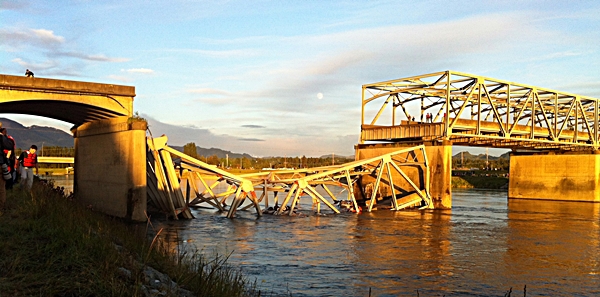Nebraska bad bridge count has gone up since Minnesota bridge collapse

INTO THE DRINK: A portion of the Interstate 5 bridge collapsed IN mAY 2013 into the Skagit River, dumping vehicles and people into the water in Mount Vernon, Wash..
By Deena Winter | Nebraska Watchdog
LINCOLN, Neb. — Nebraska is one of just nine states that have not reduced the number of structurally deficient bridges since 13 people died when a Minneapolis interstate bridge collapsed seven years ago. In fact, Nebraska has even more bad bridges today.
About one in every five bridges in Nebraska are considered structurally deficient, which doesn’t mean the bridge is about to fall down, but does mean the bridges need to be shored up or replaced.
Of Nebraska’s 15,370 bridges, 2,739 are considered structurally deficient — more than all but five other states, according to a federal bridge report. That’s nearly 18 percent of the bridges, higher than the national average of 10.5 percent.
Despite having a much smaller population, Nebraska has just 30 fewer bad bridges than California, a state with 20 times as many people — although Nebraska’s harsh winter weather takes a heavier toll on bridges and roads.
While Minnesota’s tragic bridge failure put a spotlight on ailing bridges, Nebraska hasn’t made a dent in its list of bad bridges. While the state has 105 fewer bridges than it did in 2007, it has 343 more bridges on the bad list, for an increase of 14 percent, the biggest jump in the nation.
A report by Transportation for America ranked Nebraska’s bridges the sixth worst in the nation. Nebraska bridges are an average 44 years old, a year older than the nation average and the 17th highest average in the nation. Most bridges are designed to last 50 years.
State Bridge Engineer Mark Traynowicz said most of the structurally deficient bridges are small bridges in counties and cities, which have less money to repair them. They all must be inspected every other year, and if they’re unsafe, the state will close them or post weight limits.
“So even though some of our bridges are older … if they’re open, then they’re considered safe,” he said. “If a bridge wasn’t safe, we would close it.”
Any span longer than 20 feet is considered a bridge, he said, and Nebraska has a lot of small bridges over waterways.
“Just like anything, the funds don’t equal the need,” he said.
The Legislature is doing an interim study on bridges. State Sen. Annette Dubas of Fullerton, chairwoman of the Transportation Committee, said lawmakers likely will tour counties to talk about funding challenges.
“Of course it always comes down to money,” she said. “We took aid to counties away several years ago. Did that have an impact?”
Nebraska Association of County Officials Executive Director Larry Dix said counties just don’t have the money to fix and replace enough bridges. Each year, counties might fix a handful of bridges, but not as many as they should.
“We’re probably going to continue to fall farther and farther behind,” he said.
While some states have bridge programs or bond for bridges, Nebraska counties don’t have an earmarked funding source to maintain bridges, Dix said. They get some gas tax dollars from the state and some federal highway funds, but otherwise rely on property taxes. And nobody wants to increase taxes or fees, he said.
“We keep patching and repairing and all the while we get larger equipment, larger pieces of farm equipment, going across them,” Dix said.
Bad bridges can be replaced with concrete culverts in flatter areas, but not in hilly eastern Nebraska, he said.
Part of the problem is the sheer number of bridges in Nebraska – the state went on a bridge-building spree in the 1950s and 1960s to span rivers like the Platte and Niobrara, which stretch border to border.
“While we don’t think we have a lot of water, we have a tremendous amount of water that runs all the way across our state,” Dix said.
Follow Deena on Twitter at @DeenaNEWatchdog
Editor’s note: to subscribe to News Updates from Nebraska Watchdog at no cost, click here.







